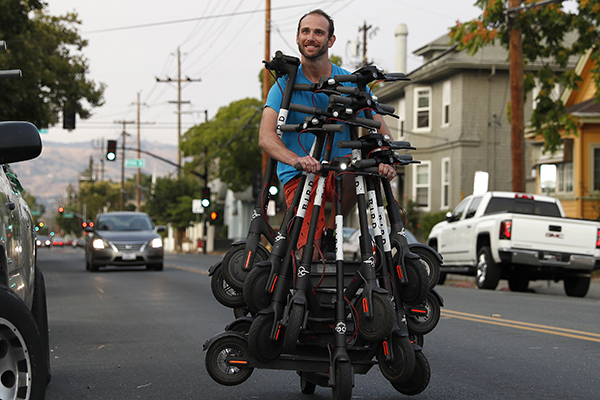Innovation / Mobility / Mobility management / Public Spaces / Sustainability / Technology / Urban Mobility Design
Sustainability and E-Scooters: Are they truly a “green” option?
At the beginning of this year, our colleague Lennart Nout wrote about this year’s new motorized mobility trend: the e-scooter. For those residing in the Netherlands, due to safety concerns and a subsequent ban following the tragic accident with an electric wagon used for transporting children, the only place they may have used one is abroad. From Brussels to Tel-Aviv, however, e-scooters are everywhere – on the streets, on the sidewalks, in public transport.

I get it. They’re cheap, easily accessible, and easy to operate. Moreover, they’re often hailed as a sustainable mode of transport, usually attributed to the ‘e’ of the e-scooter. While plenty of e-scooter opponents have voiced concerns of public safety and parking, up until now, the extent to which the vehicles are environmentally friendly has mostly been taken as a given. However a recent study out of North Carolina State University came out against many of the sustainability claims made by e-scooter companies. They conducted a life-cycle analysis of e-scooters – that is, an analysis of the vehicles’ carbon footprint, from cradle to grave. This includes the environmental impact of not only its use, but also the materials, manufacturing, and collection and redistribution.
The good news is, according to this study, mile to mile, e-scooters contribute about half the amount of emissions to that of the average car. Unfortunately, that’s about has good as it gets. If the trip you’re making by e-scooter would normally be travelled by car, then yes, that’s a significant improvement. However, if that journey would normally be travelled by foot or bicycle, unfortunately the e-scooter is not the most sustainable option. Even compared to public transport, if measured by passenger-mile travelled (ie. of a bus loaded with multiple people), the bus wins out. In short, the author ends his findings by suggesting the following three improvements if claims of e-scooters’ environmental benefits are to be taken seriously:
- Longer product lifetimes
- Reduced material burdens
- Reduced collection and distribution impacts
So does this mean that e-scooters are not a sustainable mode of transport? Well, not really. Like any proper scientific study, the findings are subject to several limitations, some of which significantly hinder the validity of the results over time and place.
Product Lifetimes and Material Burdens
The author suggests that the high rate of vandalism and theft requires that the scooters be regularly replaced, however the analysis was conducted on one particular model, namely, the Xiaomi M365, a consumer-grade scooter. So while this may be the model used in the place where the study was conducted, companies are rapidly innovating and updating models with new features making them more durable and harder to steal.
For instance, at the beginning of this month, Bird announced that they will soon be releasing the BirdTwo. The new e-scooter model boasts plenty of new features, many of which address the issues raised in the aforementioned study, including: an unexposed brake cable, puncture-proof tires, anti-theft encryption, an anti-tipping kickstand, damage sensors and a more durable steering shaft.
Collection and Redistribution
One factor that is largely overlooked by companies’ improvements is the collection and redistribution of the scooters. Every day, various scooters need to be collected, charged overnight, and then redistributed throughout the city, a process that still seems riddled with inefficiencies. Given that the independent contractors that collect the vehicles are paid per scooter and charge them in their own home, it is effectively a competition between collectors to gather as many as possible, by whatever means possible. Herein lies another large chunk of the carbon footprint of e-scooters.
This study however, was conducted in the United States, where contractors often gather scooters with their personal vehicles and where urban density is usually quite low. Overseas, where both population as well as structural density are typically higher, contractors are probably travelling shorter distances to collect and redistribute scooters, slightly increasing efficiency. The means by which scooters are gathered could also make a quite a difference in the carbon footprint. In Israel for example, it is not uncommon to see people zipping down the street riding a scooter with several others piled on top of the it, clearly collecting them for charging.
And in the Netherlands?
Unsurprisingly, the Dutch still prefer the good ol’ bicycle, and for good reason. This is not because all Dutch residents fervently strive to save the planet, but rather for practical reasons. High-quality, connected and efficient cycling infrastructure has already been in place for decades, including parking, plenty of shops to repair your bike, and dedicated bicycle streets. Plus, since so many people already own a bike, it may be difficult to convince the public to use a different vehicle demonstrating marginal advantages to the bicycle. If e-scooters want to take off here as an accepted mode of transport, they have many hurdles to overcome which the bicycle has long since settled, including accessibility for the aged and/or disabled, appropriate riding speeds, and where they can and should be parked, just to name a few.
Ultimately, the e-scooter invasion still seems far-off in the low-countries, but regardless of what happens here, a critical eye should be kept on the eco-friendly claims made by e-scooter companies. Let’s be clear, they are FAR superior than cars. Their use is emissions free, they take up far-less space, and so far they’re still a fun new way of hopping around town. Though when the novelty wears off and their effects are seen at a more systematic level, municipalities are going to have to make some major decisions about where they fit into their vision of the future of urban mobility.
 ">
">Stephen Kurz
‘Though we are strongly influenced by our environment, effective urban design can help us make sustainable, healthy, and safe choices. Not because we’re more aware of our choices, but because we’re not. Good urban design makes the ‘right’ choice easy. To achieve this, I value non-traditional approaches to exploring and developing solutions to urban issues.’

